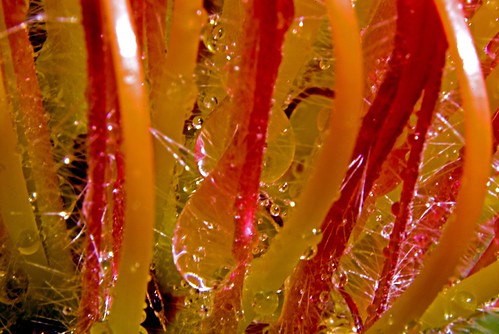This is one of my first photographs taken with Nikon’s new prosumer model, the D200. I think it is qualitatively (as well as quantitatively) better than my beloved D70 workhorse.
By qualitatively better, I mean that I think the sensor array does a better job than can just be explained by the added pixel resolution. Check out the macro photo of a leucospermum flower in my garden at the larger size, and I think you’ll see what I mean.
Of course, there’s a learning curve, and it will take me a while before the meaning of all those little inscrutable icons becomes second nature.
The D200 continues the progression of digital cameras internalizing controls into the command center. There are more things you need to set on the LCD screen, or using command wheel button items, rather than just setting on the exterior of the camera body. For example, there are now just four primary shooting modes: P (Program), S (Shutter-preferred), A (Aperture-preferred), M (Manual). If you want to tell the camera to use one of its programs optimized for a specific situation, such as a landscape or portrait, you have to select that as a secondary item. This contrasts with the D70 in which all the programmed modes were available from a single prominent wheel control.
As I’ve said, digital cameras are a hybrid, one part camera and one part computer. The trend of internalizing and centralizing the interface is part of the process of acknowledging the computer portion of this heritage.
If you are new to the D200, you might want to know about a couple of settings buried within menus that I changed from the default. (Look these items up in the almost inscrutable manual for the specific mechanics.)
First, I changed the default color space used by the camera from sRGB to Adobe AdobeRGB. The sRGB color space is a really crappy (that’s the only word for it) generic color space that would make sense for snapshots and plays on old monitors. By selecting AdobeRGB, I get a far wider gamut of colors. You can really see the difference when you open a D200 RAW capture in 16-bit mode in Photoshop. (This is set using the Color Space selection on the Shooting menu.)
Second, there’s now an option to compress RAW captures on the memory card. This is lossless compression that doubles the number of RAW captures you can fit on a CF memory card (and helps to make storage issues less intense generally). A compressed RAW on the D200 is a little smaller than a non-compressed RAW on my D70 (which has no compression option), and has a lot more pixels. (Choose the RAW compression item on the Shooting menu.)

Pingback: Photoblog 2.0: » Photoblog 2.0 Archive: » Flower within the Flower
rudib
8 Apr 2007I’m sorry to say so, but I’m afraid the statement about the D70 doing no RAW compression is wrong. In fact, the D70 and D70s ALWAYS perform RAW compression. Thom Hogan (at http://www.bythom.com/currentdslr.htm) shows an overview of compression modes and options for various Nikon D-SLR’s, and his D200 book explains in detail how that compression works (quite different from JEPG compression, in fact!).
I had a D70 before having a D200, and the D200 RAW files in compressed mode are on average somewhat larger (from 8.5 to 10.5 MB) than the – by definition -compressed D70 files (usually 5.5 to 6 MB each). I turned RAW compression on my D200. That saves valuable space on the memory card, but unfortunately the counter of remaining exposures is completely incorrect in that case. This seems to be a know issue for Nikon users, and I hope a future firmware update will address this….
best, rudi